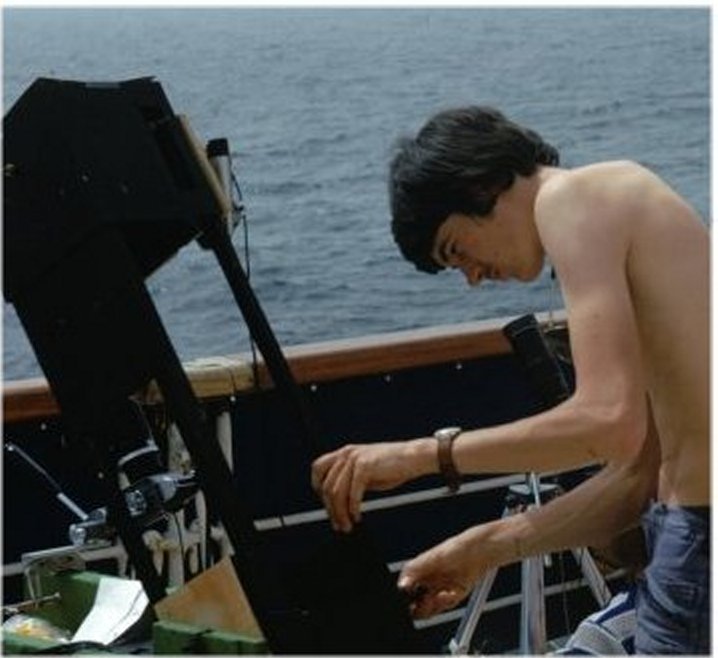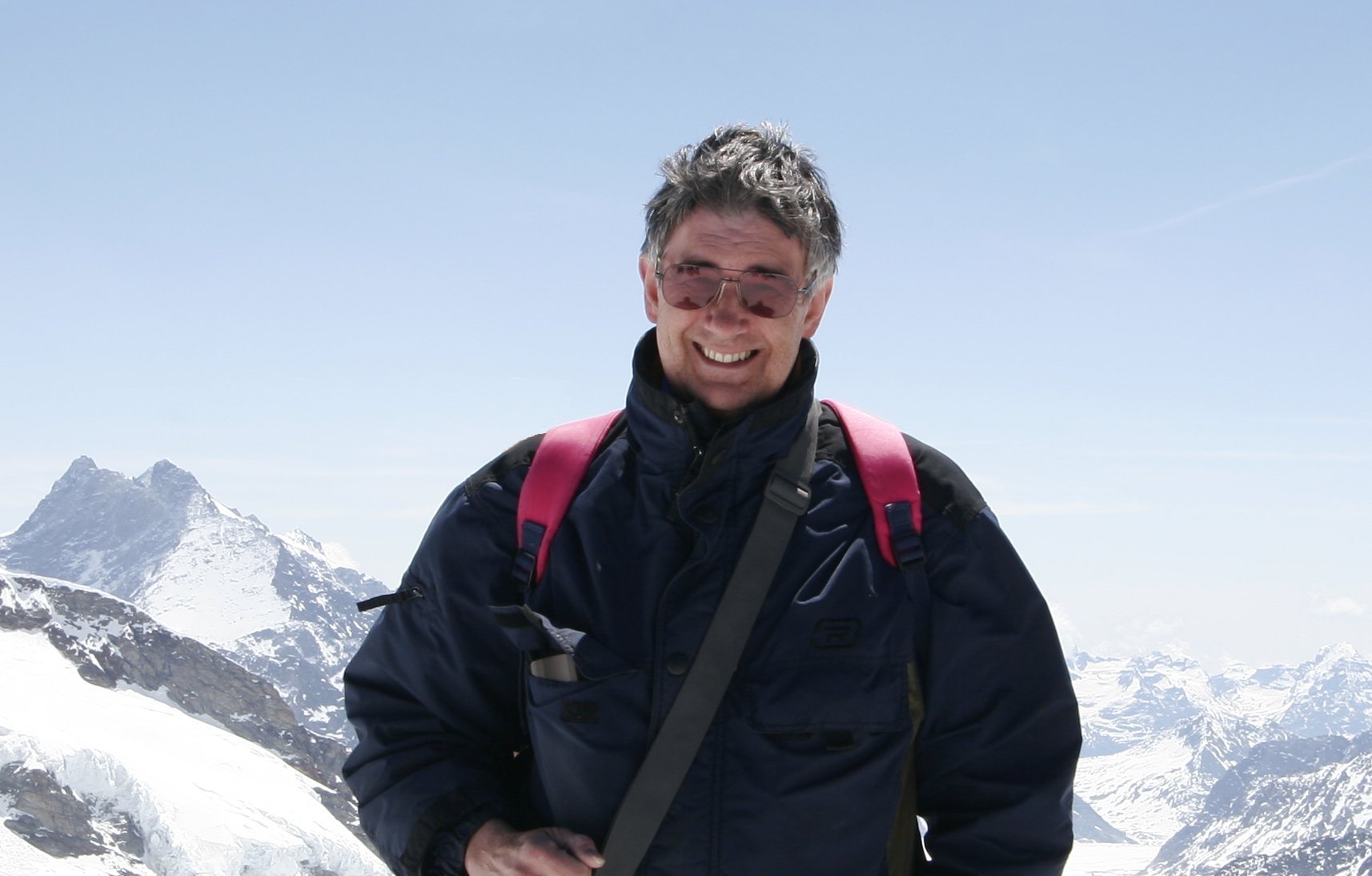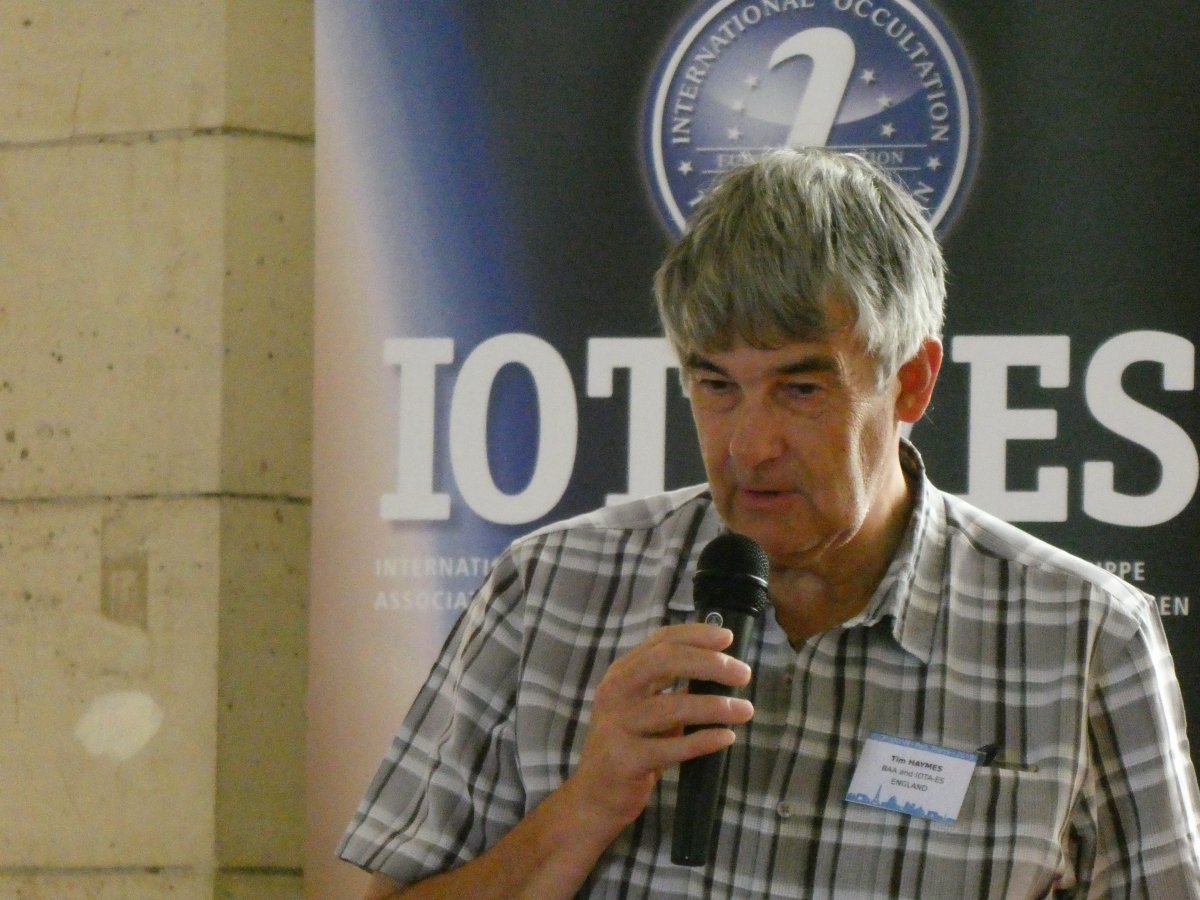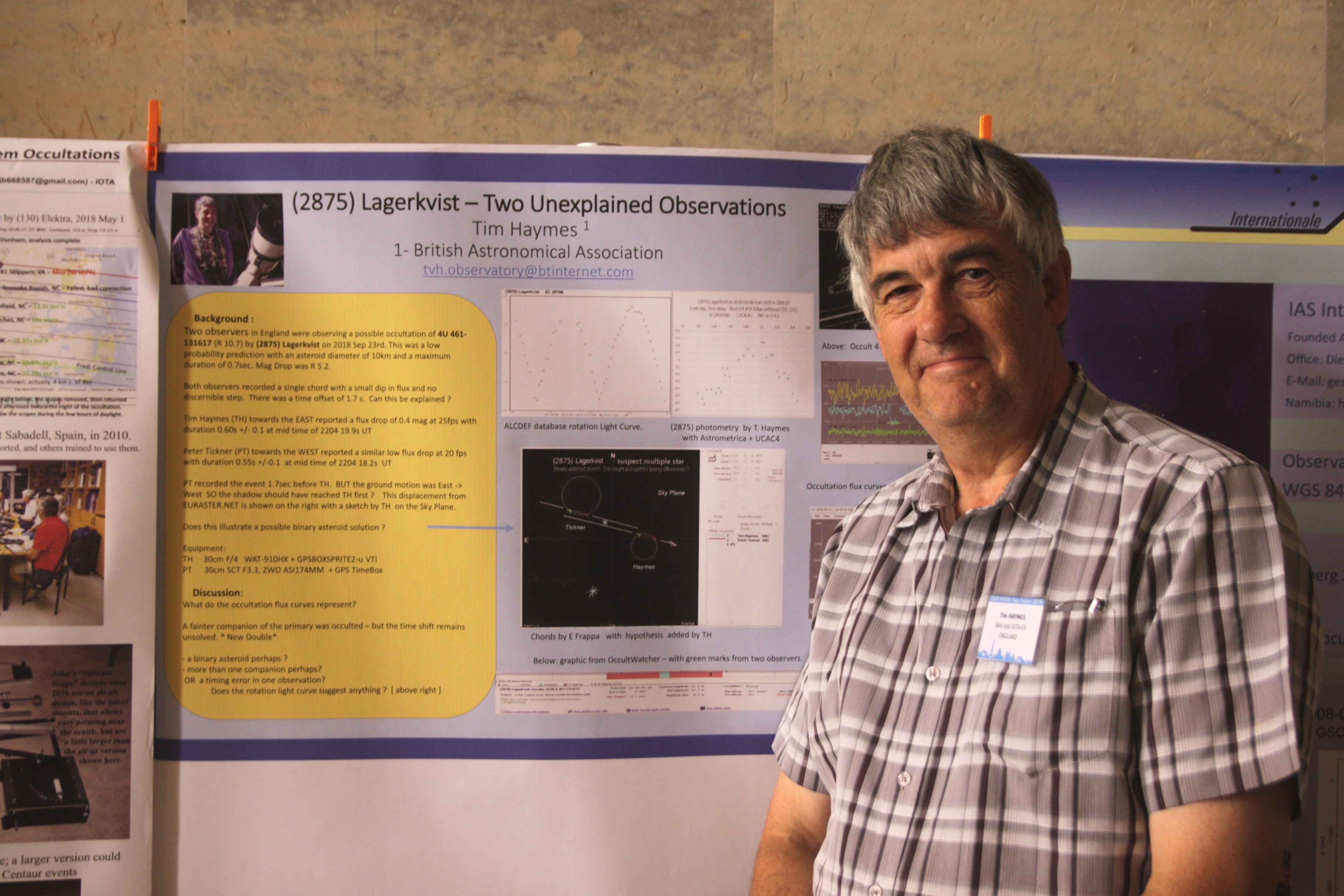



Tim Haymes BSc MRSC.
AutoBiographical




Tim Haymes BSc MRSC.
[1973 Monte Umbe eclipse cruise]...[2012 on the Jungfrau, Switzerland].....[
European Symposium on Occultation Projects (ESOP
38) Cassini Room, Paris Observatory 2019].
Photo credits: IOTA-ES: Oliver and Roland
Astronomical
Interests
There are so many interesting aspects.
Joining a local astro group helped enormously. Although i like to look through
telescopes as much as anyone. I have settled into "electronic assisted"
methods.
In other words, taking images because they can be analysed and shared.
I used transparency film up to about year 2000 using a Pentax SLR and red sensitive
film like GAF500.
I also used Tech Pan 2415
film and did my own processing of Moon shots, and experimented with hydrogen
hyper-sensitisation.
Now i use a Canon DSLR for wide area images of the night sky and a USB3 camera
attached to the telescope for nebulae, galaxies, planets, comets and asteroids.
So my main area of interest is recording and timing occultations
by asteroids or the Moon.
Many of my asteroid and
lunar graze
observations are on these pages. Timing results are recorded on EURASTAR.NET
web site.
One of the overall aims is to get an accurate position of an asteroid relative
to the star, and to measure an asteroid's size and shape from the timings.
This is possible when many observers record the same occultation
from difference places such as this
recent report.
These are powerful techniques for examining very distant and small objects that
a large telescope cannot resolve. (Even Hubble!).
Its all done with small telescope of 4 -10" aperture using video and GPS
time.
The observer reports the occultation time and the resuts are generated by other
collaborators
Equipment, 1969 to 2022
Development of my astronomical video recording equipment is
summarised on this page
My first telescope was a DIY 6" F8 reflector
(made ca 1969).
The main mirror and flat were bought from AE Luton Ltd and the focuser and eyepieces
from Fullerscopes, London.
It had a square part-skeleton tube
made from materials (mostly wood) in my Dad's workshop. The mounting was a fork,
based around a discarded Morris-Minor half axial.
A later modification used a captive-nut drive
around the break-drum and a Meccano gearbox and motor to obtain sidereal slow
motion.
At the same time i had use of the Maidenhead Astro group 8"/F6 reflector
which i later "inherited" since no-one in the group wanted to take
on its maintenance and storrage.
The telescope continued to be used at astro open evenings and outreach events.
I made a varished slatted
tube for the 8" F6 in 1980.
The new 8" OTA was mounted on a Fullerscopes
MkIII equatorial mount with synchronous drive,
and this was my main instrument up to 1992.
In 1991/2 i built a10ft
observatory dome to house the 8" F6, but soon after i bought a
AE 12" F6 from Eddie
Moore of Reading Astro.
I replaced the secondary mirror with one by David Hinds.
The optics in the AE were not original which would have been nice.
Overall the telescope was a bit of a beast and then i damaged the 240v sidereal
drive controller.
To replace it, i built a design by Cmdr. Henry Hatfield
(past BAA Instruments Section).
Overall the AE mounting was not good enough for planetary imaging with a Philips
2Ucam pro webcam because the worm and wheel had a periodic error.
However i did get some great images of Jupiter and Saturn.
The AE 12" was sold to Bedford
School arround 2003 AD, and i understand the instrument
was later passed on to a collector in the East Anglia area.
At that time I took the plunge to buy a Meade
LXD55 SN8 goto instrument. It cost £1138
from Telescope House on 2003 Jul 2nd.
This mount was a revelation, but it soon became clear that the LXD55 mounting
was not up to the main imaging tasks.
So i bought an SkyWatcher EQ6 pro from Ian
King Imaging in late 2005 (£1020).
This was a wonderful mounting, and still is ! [ The motor control board was
replaced in late 2020]
The 8" F4 Meade was ideal for the EQ6pro
(Also a mobile unit for occultations), and
it was controlled by EQMod.
I was also using the Meade DSI IIpro camera
for imaging, a fantastic camera for its time on the EQ6 without the need for
auto guiding.
Aperture fever struck again in 2006 during AstroFest, and I
bought an Orion Optics (UK) 30cm F/4 in Feb 2006
(£1095), with 1/8 pv upgrade.
The EQ6pro and OO 30cm made an excellent combination, and the mount can take
21kg fine.
Here is the 30cm in Obs at 25th Aniv
in 2017. But I now (2021-2) have C11 XLT
on EQ8 mount. The OO 30cm is under cover and i will return to it.
Now the C11 on EQ6pro is powerfull mobile
combination for Pro-Am occultation work.
A Pulsar 2.7m dome was installed at our new home in February 2021.
Memberships:
Member of British Astronomical Association from 1974 [ Applied in June1973,
proposed by Cmdr
H.R Hatfield, and seconded (it was indicated)
by Alex Boksenberg
CBE FRS, then Director
of the RGO)
Assistant Director (Occultations) - BAA Asteroids & Remote Planets
Section (2010-
Coordinator, BAA Lunar Section - Lunar Occultations ( 2010 -
Member of IOTA-ES (2010- )
Life Member of Maidenhead Astronomical Society (formed 1957), Membership
Secretary 1973-1976, 1979-1983, 1990-2007 - Meetings Secretary 2008-2018.
Life Member of Aylesbury Astronomical Society (Granted in 1985 for
payment of repairs to the Colin Hunt Observatory
building , at Upper Winchendon).
Member and friend of Reading Astronomical Society 1973-2018
Past Member of Salford Astronomical Society 1975-1976. Happy memories
during my University years.
Presently a member of Abingdon A.S.
Events
and Observations
Observed the longest Total Solar Eclipse of the 20th Century
on 30th June 1973, onboard the good ship Monte
Umbe.
Made the first continuous recording with Super8 cine film of a lunar graze occultation,
Aldebaran, on 1978 August 26th.(see JOA)
Witnessed the Perseid meteor storm (>100/hr)
on 1980 Aug 12/13 from Bradfield, Berkshire. [1]
- "driving through torrential rain on the M4, I arrived at Bradfield
to find clear sky and celestial fire-works in progress".
Photographed Comet 1P Halley in October 1985, which was one of the earliest
return images obtained from the UK
Witnessed the Great Aurora
of March 13,1989 ( a "Charrington" event), originating from a solar
storm.
Video recorded Titan occulting 28 Sagittarii on 1989 July 3rd.[2]
- "Two photo diodes were used in "difference mode" to output
the TV screen to a chart recorder.
The central flash was seen but not recorded".
Comet SL9 impacts on Jupiter 1994 July 20th. Drawings
made with AE12" F6
Observed the Leonid Bolide Storm of 1998 Nov 17 while taking part in the BAA
Meteor Section triangulation team. [3]
BERMUDA: To record a very
rare occultation of a 1st magnitude star "Regulus" by asteroid Erigone
on 2004 March with video cameras
- Dr.David Dunham (IOTA) joined us the day before, but we were all unexpectedly
clouded out.
The US was in the grip of a winter storm and Bermuda
was the only alternative loaction, and pleasently warm.
Transit of Venus - June 2004
Draconid outburst in 2011 Oct 8th seen from Maidenhead. [4]
- "10 meteors in 30min, were seen between cloud and in Moonlight,of
magnitude 2-3 following an alert from John Mason"
UK - ASTEROIDS well observed
Acknowledegments : Profiles from Occult4 (D.
Herald), writeups: British Astonomical Association
2010 Feb 20 - 6
chords across (130)
Electra ( 256x154 Km )
2015 Sep 30 - 15 chords +3 miss
across (275)
Sapientia (JBAA 125 ,6,2015)
2018 Apr 21- 9
chords across (130)
Electra [42 inc.European] (JBAA 128,3,2018)
2018 Oct 29 - 18 chords across
(156) Xanthippe
(107 x 95 Km)
2020 Feb 10 - 7
chords across (87)
Sylvia [+1 EU]
2021 Apr 24 - 4 chords across
(159)
Nuwa
2022 Apr 15 - 6 chords +1 miss
across (22)
Kalliope [+4 EU]
2022 Aug 11 - 5 chords +3 miss
across (2241)Alcathous
[+1 EU]
2024 Nov 27 - 5 chords across
(350) Ornamenta [Occult DB]
2025 Sep 13 - 12 chords across
(426) Hippo [preliminary]
GREAT Comets
Bennett 1969, West
1976, Hale-Bopp 1995, McNaught
2007, Neowise 2020, Leonard
2021
2022E3 ZTF.. 2022E3..2022E3..in
2022 (Jan), 2023EF in 2023,
12P in 2024, C/2023A3
(Tsuchinshan-ATLAS) , 2025A6 Lemmon,
C/2025K1 fragmenting
Double Star observation by Occulation Method, in http://www.jdso.org/jdso_index.php
See reports #5,#6, #7
First dual-station
positive asteroid occultation in the UK (Home and Remote stations)
for (5022) Roccapalumba on 2022 Jan 12th
Second dual station positive (3704)Gaishiqi
on 2025 Aug 10 - a possible unconfirmed "binary asteroid".
Good Aurora displayes in 2024
May-10,
Oct-11
[1] JBAA 1981, 81 J .Mason
and I. Sharp
[2] JBAA 1994 April p61. Vol, 104 No2 - R.Miles and
A.J.Hollis
[3] JBAA 1999 October Vol.109 No.5 p239
- The Leonid shower 1981-1997 and rise to 1998/99 - N Bone and
S Evans.
[4] JBAA 2011 December
p326, Vol.121 No.6 J.Mason
Publications and contributions.
Grazing Occultation of 37 Sagittarii on 1974 October 21
- G.M.Appleby. JBAA 1976, 87,1
- T Haymes is a named observer. He was observing near
Petworth, Sussex. See this page for details
Light Curve of the 1978 August 26
Lunar Graze of Aldebaran - JOA
2011-2, p13
- The author used digitised cine film and Tangra software-.
cited by Neil Bone in: Observing Meteors,Comets and other Transient
Phenomena on pages 82-3
The Dynamical Evolution of a Tubular Persistent Train - Earth,
Moon, and Planets. Vol 82-83; 471-488 (2000). ISSN 0167-9295.
- Peter Jenniskens used my video tape of a bright Leonid persistant
train. Also JBAA
Observations of binary black hole candidate OJ287
Structure and Evolution of the October/November 2005 outburst. Astronomy
& Astrophysics Vol
477, 407-412 (2008)
- M. Kidger, G Poyner et. al.
BAA Winchester Weekend 2010 - Poster describing Four Recent asteroidal occultations
Asteroidal occultation observed from UK and Europe.
BAAJ 2011 August p194. Vol.121 No.4
- Asteroid (42) Isis occulted a 11th mag star on May 3rd.
Lunar Occultation of double stars - a plea for observes, A.R Pratt - JBAA 2012 June p177, Vol. 122 No.3
Successful observations of (241) Germania occultation on 2014 April 18 - Observers' Forum JBAA 2014 June p166, Vol.124 No.3, or pdf.
Stellar occultation by asteroid (275) Sapientia well seen from the UK - JBAA 2015 December p331, Vol. 125 No.6, or pdf.
The 35th European Symposium on Occultation Projects (ESOP
XXXV) held at University of Guildford, 2016 Aug 19-21
- organised by T Haymes and the BAA. JBAA 2016
December p371-2, Vol. 126 No.6, or view the pdf.
Thirteen contacts observed during one grazing occultation! Fl 81 Tauri on 2017 Feb 5, JBAA 2017 April p115 Vol. 127 No.2, or pdf
The 2017 May 20th stellar occultation
by the elongated centaur (95626) 2002 GZ32 -
Santos-Sanz, Ortiz, Sicardy et al
- The draft paper cites my negative
(text file) observation by this Centaur.
Constraints on the structure and seasonal
variations of Triton's atmosphere by stellar occultation
of 5 Oct 2017
- Astronomy & Astrophysics January 26, 2022. J Marques Oliveira,
B. Sicardy and 200+ co-authors, includes
obs by T.V.Haymes. See pdf.
The Occultation of UCAC4 410-143659
by Triton - Observers' Forum JBAA
2017 December p366,
Vol. 127 No.6 or pdf.
.
Contributed prediction pages to Handbook of BAA, yearly from 2010.
(130) Elektra occultation successfully observed across Europe
- JBAA 2018 June p132-133
or pdf.
- Co authored with R.Miles (Director) and A.Pratt. NB: Elektra was also observed
in 2010.
(156) Xanthippe Occultation -
Notes and News JBAA 2018
February P6. Vol. 129 No 1, or pdf.
- Many successful observations from across the UK
Obituary of Gordon E.Taylor JBAA 2020 October [ Notes *]
Asteroid (4) Vesta Occults a bright star. Notes&News JBAA 2020 Feb. p4 {vol 130 No.1}
On 2021 Sept. 20/21, Centaur (95656)2002GZ32 occulted UCAC4_351_123801 (Lucky-Star prediction )
Double star unexpectedly detected during an asteroid occultation:
P.Denyer.
- A FIRST FOR THE UK. JBAA 2022 February P17. {Vo l. 132, No
1} or pdf
Contribution to: (1429) Pembra and (14835) Holdridge light curve photometry: Author - Wayne Hawley (in progress 2024)
The 2023 Dec 12 occultation of Betelgeuse (by asteroid (319)Leona)
JBAA Vol 134, 3, P168 (2024 June)
A well-observed occultation by asteroid (350) Ornamenta JBAA Vol 135,1,P14
(2025 Feb) or pdf
Contribution to: Asteroid Size determined with thermophysical
model and stellar occultations A&A, 698, A298, (2025)
A named observer as joint author (among many)
Contribution to: Lightcurve and Rotation Period Analysis
of asteroids Journal of.. (2025)
(9058) 1992 JB, (424482)2008 DG5 - Wayne Hawley and Patrick Wiggins
A named observer among many.
----------------------------------
* Added 2022 May 10. The Occultation News Letter (ON) describes how G.Taylor exposed plates using a refractor at Hersmonceux to confirm a prediction, subsiquently observed in the US. ON Vol 2, No 6, November 1979, page 56
Tim Haymes 2022 June 15
Tim Haymes 2024 Feb - somel typos corrected
Tim Haymes 2025 June - updated.